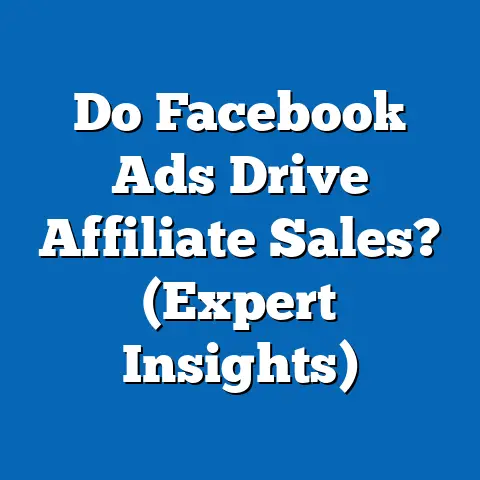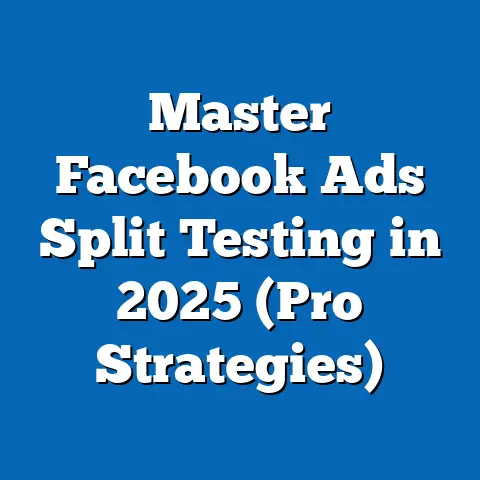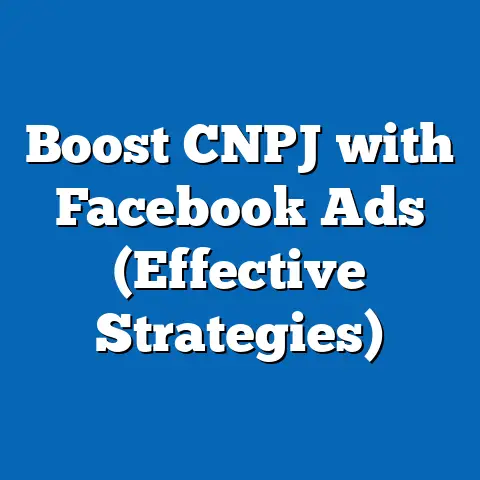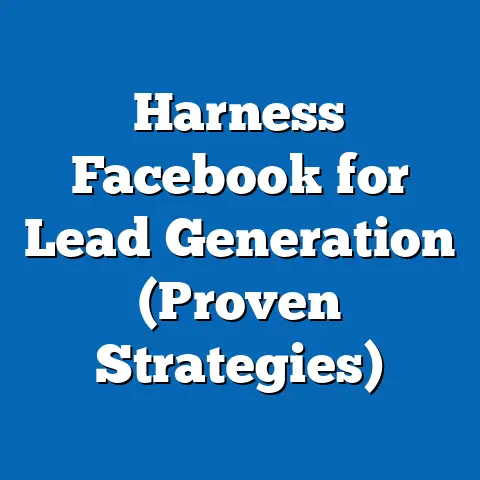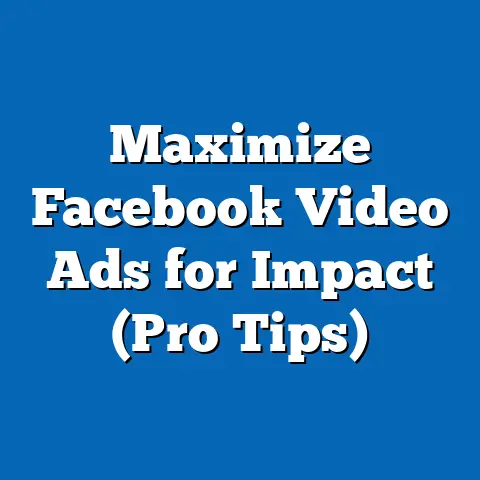Maximize fb ad Reach with Dynamic Catalogs (Proven Strategies)
In today’s fiercely competitive digital landscape, capturing attention is the name of the game. Facebook advertising, with its vast reach and sophisticated targeting capabilities, remains a cornerstone of many marketing strategies. But with countless ads vying for users’ attention, how do you ensure your message breaks through the noise? The answer lies in a powerful combination: bold design and dynamic catalogs. Studies have shown that visually appealing ads can increase engagement rates by up to 56%. Dynamic catalogs, on the other hand, allow for personalized and relevant product recommendations, leading to higher click-through rates and conversions. In this article, I’ll delve into proven strategies that marry these two elements, helping you maximize your Facebook ad reach and drive real business results. Get ready to transform your Facebook advertising game!
Understanding Dynamic Catalogs
Dynamic catalogs are a game-changer for businesses looking to streamline their Facebook advertising efforts. At their core, they’re automated systems that display relevant products from your online store directly to potential customers on Facebook and Instagram. Think of them as your personalized digital storefront, showcasing your best offerings to the right people at the right time.
What are Dynamic Catalogs?
Unlike static ads that require manual updates, dynamic catalogs automatically pull product information from a “feed.” This feed is essentially a spreadsheet or XML file containing details like product name, description, image URL, price, and availability. Facebook then uses this data to create visually appealing ads that are tailored to individual users based on their past behavior, interests, and demographics.
Setting Up Your Dynamic Catalog
Creating a dynamic catalog involves a few key steps:
-
Create a Product Feed: This is the most crucial part. You’ll need to gather all your product information and format it according to Facebook’s specifications. Most e-commerce platforms offer plugins or extensions that automate this process. For example, if you’re using Shopify, you can use the Facebook channel app to create and manage your product feed.
-
Upload the Feed to Facebook Business Manager: Once your feed is ready, you’ll upload it to your Facebook Business Manager account. Navigate to the “Catalogs” section and follow the prompts to create a new catalog.
-
Connect Your Pixel: Ensure your Facebook Pixel is properly installed on your website. This allows Facebook to track user behavior and show them relevant products they’ve previously viewed or expressed interest in.
-
Set Up Your Ad Campaigns: Now the fun begins! You can create dynamic product ads within Facebook Ads Manager, selecting your catalog as the data source. You can then define your target audience, budget, and ad creative.
Create a Product Feed: This is the most crucial part. You’ll need to gather all your product information and format it according to Facebook’s specifications. Most e-commerce platforms offer plugins or extensions that automate this process. For example, if you’re using Shopify, you can use the Facebook channel app to create and manage your product feed.
Upload the Feed to Facebook Business Manager: Once your feed is ready, you’ll upload it to your Facebook Business Manager account. Navigate to the “Catalogs” section and follow the prompts to create a new catalog.
Connect Your Pixel: Ensure your Facebook Pixel is properly installed on your website. This allows Facebook to track user behavior and show them relevant products they’ve previously viewed or expressed interest in.
Set Up Your Ad Campaigns: Now the fun begins! You can create dynamic product ads within Facebook Ads Manager, selecting your catalog as the data source. You can then define your target audience, budget, and ad creative.
Who Benefits Most from Dynamic Catalogs?
While dynamic catalogs can benefit a wide range of businesses, they’re particularly effective for:
- E-commerce Retailers: This is the most obvious application. Dynamic catalogs allow e-commerce businesses to showcase their entire product range to potential customers, driving traffic and sales.
- Travel Agencies: Imagine showing users personalized travel packages based on their past searches and destinations. Dynamic catalogs make this a reality.
- Real Estate Agencies: Showcase available properties to potential buyers based on their location preferences, budget, and other criteria.
- Automotive Dealers: Display new and used vehicles to users who have shown interest in specific makes and models.
Key Takeaway: Dynamic catalogs automate your Facebook advertising, allowing you to show personalized product recommendations to the right people at the right time, ultimately driving more sales.
The Power of Bold Designs in Facebook Ads
In a world saturated with information, grabbing attention is paramount. That’s where bold designs come in. A well-designed ad can be the difference between a scroll-past and a click-through.
Why Bold Design Matters
Bold designs are visually striking and memorable. They use elements like vibrant color schemes, eye-catching typography, and high-quality imagery to instantly capture attention. Think of it as creating a visual “stop sign” in the user’s news feed.
- Stands Out from the Crowd: A bold design helps your ad stand out from the sea of other content vying for attention.
- Communicates Quickly: Visuals are processed much faster than text. A bold design can quickly convey your message and pique interest.
- Creates a Strong Impression: A well-designed ad leaves a lasting impression, making your brand more memorable.
Examples of Successful Bold Design Campaigns
Let’s look at a few examples:
-
Nike: Nike often uses bold, minimalist designs with striking imagery of athletes in action. Their color schemes are often high-contrast, and their typography is clean and impactful.
-
Airbnb: Airbnb frequently uses high-quality photos of unique and desirable properties. They often incorporate vibrant colors and playful typography to create a sense of wanderlust.
-
Dollar Shave Club: Dollar Shave Club is known for its humorous and irreverent ads. They use bold colors, quirky illustrations, and witty copy to stand out from the competition.
Nike: Nike often uses bold, minimalist designs with striking imagery of athletes in action. Their color schemes are often high-contrast, and their typography is clean and impactful.
Airbnb: Airbnb frequently uses high-quality photos of unique and desirable properties. They often incorporate vibrant colors and playful typography to create a sense of wanderlust.
Dollar Shave Club: Dollar Shave Club is known for its humorous and irreverent ads. They use bold colors, quirky illustrations, and witty copy to stand out from the competition.
Complementing Dynamic Catalogs with Bold Design
Key Takeaway: Bold design is crucial for capturing attention and creating a memorable impression in Facebook advertising. When combined with dynamic catalogs, it amplifies the effectiveness of your ads by making them both personalized and visually striking.
Proven Strategies to Maximize FB Ad Reach with Dynamic Catalogs
Now, let’s dive into the actionable strategies that will help you maximize your Facebook ad reach using the combined power of dynamic catalogs and bold designs.
Strategy 1: Personalized Ad Experience
The key to successful dynamic catalog advertising is personalization. By showing users products they’re genuinely interested in, you increase the likelihood of a click-through and a purchase.
-
Audience Segmentation: Segment your audience based on their past behavior, interests, and demographics. For example, you might create segments for users who have viewed specific product categories, added items to their cart but didn’t complete the purchase, or are located in a specific geographic area.
-
Retargeting Strategies: Retargeting is a powerful tool for reminding users about products they’ve previously viewed. Create retargeting campaigns that show users the exact products they were looking at, along with similar items they might also be interested in.
-
Custom Audiences: Leverage your customer data to create custom audiences. Upload your email list or phone numbers to Facebook and target ads specifically to your existing customers.
Audience Segmentation: Segment your audience based on their past behavior, interests, and demographics. For example, you might create segments for users who have viewed specific product categories, added items to their cart but didn’t complete the purchase, or are located in a specific geographic area.
Retargeting Strategies: Retargeting is a powerful tool for reminding users about products they’ve previously viewed. Create retargeting campaigns that show users the exact products they were looking at, along with similar items they might also be interested in.
Custom Audiences: Leverage your customer data to create custom audiences. Upload your email list or phone numbers to Facebook and target ads specifically to your existing customers.
How to Set Up Personalized Dynamic Ads:
-
Create Custom Audiences: In Facebook Ads Manager, navigate to the “Audiences” section and create custom audiences based on your website visitors, customer list, or app users.
-
Set Up Dynamic Retargeting: When creating your ad campaign, select the “Catalog Sales” objective and choose your dynamic catalog. Under “Audience,” select the retargeting option and specify the timeframe (e.g., retarget users who viewed products in the last 30 days).
-
Personalize Ad Copy: Use dynamic ad copy to personalize your message. For example, you can use the product name, price, or a special offer in your ad copy.
Create Custom Audiences: In Facebook Ads Manager, navigate to the “Audiences” section and create custom audiences based on your website visitors, customer list, or app users.
Set Up Dynamic Retargeting: When creating your ad campaign, select the “Catalog Sales” objective and choose your dynamic catalog. Under “Audience,” select the retargeting option and specify the timeframe (e.g., retarget users who viewed products in the last 30 days).
Personalize Ad Copy: Use dynamic ad copy to personalize your message. For example, you can use the product name, price, or a special offer in your ad copy.
Example: Imagine a user browsed a specific pair of running shoes on your website. Your dynamic retargeting ad could show them that exact pair of shoes, along with a message like, “Still thinking about those running shoes? Get them now with free shipping!”
Key Takeaway: Personalization is paramount. Segment your audience, leverage retargeting, and personalize your ad copy to show users products they’re genuinely interested in.
Strategy 2: Utilize Eye-Catching Creatives
Even the most personalized ad will fall flat if it’s not visually appealing. That’s why it’s crucial to combine your dynamic catalogs with eye-catching creatives.
-
High-Quality Product Images: Use professional-quality product images that showcase your products in their best light. Ensure your images are well-lit, properly cropped, and visually appealing.
-
Bold Color Schemes: Use color schemes that are consistent with your brand and that stand out from the Facebook news feed. Consider using contrasting colors to draw attention to key elements of your ad.
-
Compelling Typography: Choose fonts that are easy to read and that complement your brand’s aesthetic. Use different font sizes and weights to create visual hierarchy and draw attention to important information.
-
Video Ads: Consider using video ads to showcase your products in action. Video ads are highly engaging and can be a great way to capture attention.
High-Quality Product Images: Use professional-quality product images that showcase your products in their best light. Ensure your images are well-lit, properly cropped, and visually appealing.
Bold Color Schemes: Use color schemes that are consistent with your brand and that stand out from the Facebook news feed. Consider using contrasting colors to draw attention to key elements of your ad.
Compelling Typography: Choose fonts that are easy to read and that complement your brand’s aesthetic. Use different font sizes and weights to create visual hierarchy and draw attention to important information.
Video Ads: Consider using video ads to showcase your products in action. Video ads are highly engaging and can be a great way to capture attention.
Tips for Designing Bold Creatives:
-
Keep it Simple: Don’t overcrowd your ad with too much information. Focus on a single, clear message and a strong visual.
-
Use White Space: White space (or negative space) can be a powerful design element. It helps to create a sense of balance and allows the eye to focus on the key elements of your ad.
-
Maintain Brand Consistency: Ensure your ad creatives are consistent with your brand’s overall aesthetic. This will help to build brand recognition and create a cohesive experience for your customers.
Keep it Simple: Don’t overcrowd your ad with too much information. Focus on a single, clear message and a strong visual.
Use White Space: White space (or negative space) can be a powerful design element. It helps to create a sense of balance and allows the eye to focus on the key elements of your ad.
Maintain Brand Consistency: Ensure your ad creatives are consistent with your brand’s overall aesthetic. This will help to build brand recognition and create a cohesive experience for your customers.
Example: Instead of using a standard product image with a plain background, create a lifestyle image that shows the product being used in a real-world setting. Use a vibrant color scheme and compelling typography to draw attention to the key features of the product.
Key Takeaway: Eye-catching creatives are essential for capturing attention and driving engagement. Use high-quality product images, bold color schemes, compelling typography, and consider using video ads to showcase your products in action.
Strategy 3: A/B Testing for Optimization
No matter how well you think you know your audience, there’s always room for improvement. A/B testing (also known as split testing) is a powerful tool for optimizing your dynamic catalog ads and maximizing your ROI.
-
Test Different Headlines: Try different headlines to see which ones resonate best with your audience. For example, you might test a headline that focuses on a specific benefit of the product versus a headline that focuses on a discount or promotion.
-
Test Different Visuals: Experiment with different product images or video ads to see which ones generate the most clicks and conversions.
-
Test Different Call-to-Action Buttons: Try different call-to-action buttons to see which ones are most effective. For example, you might test “Shop Now” versus “Learn More” or “Add to Cart.”
-
Test Different Audience Segments: Experiment with different audience segments to see which ones are most responsive to your ads.
Test Different Headlines: Try different headlines to see which ones resonate best with your audience. For example, you might test a headline that focuses on a specific benefit of the product versus a headline that focuses on a discount or promotion.
Test Different Visuals: Experiment with different product images or video ads to see which ones generate the most clicks and conversions.
Test Different Call-to-Action Buttons: Try different call-to-action buttons to see which ones are most effective. For example, you might test “Shop Now” versus “Learn More” or “Add to Cart.”
Test Different Audience Segments: Experiment with different audience segments to see which ones are most responsive to your ads.
How to Conduct A/B Tests:
-
Identify What to Test: Choose one element of your ad to test at a time. This could be the headline, visual, call-to-action button, or audience segment.
-
Create Two Variations: Create two variations of your ad, each with a different version of the element you’re testing.
-
Run the Test: Run the test for a sufficient period of time (typically at least a week) to gather enough data to draw meaningful conclusions.
-
Analyze the Results: Analyze the results of your test to see which variation performed better.
-
Implement the Winning Variation: Implement the winning variation in your ad campaign and continue testing other elements to further optimize your performance.
Identify What to Test: Choose one element of your ad to test at a time. This could be the headline, visual, call-to-action button, or audience segment.
Create Two Variations: Create two variations of your ad, each with a different version of the element you’re testing.
Run the Test: Run the test for a sufficient period of time (typically at least a week) to gather enough data to draw meaningful conclusions.
Analyze the Results: Analyze the results of your test to see which variation performed better.
Implement the Winning Variation: Implement the winning variation in your ad campaign and continue testing other elements to further optimize your performance.
Example: You might test two different headlines for your dynamic catalog ad: “Shop Our Latest Collection of Summer Dresses” versus “Get 20% Off All Summer Dresses.” Run the test for a week and analyze the results to see which headline generated more clicks and conversions.
Key Takeaway: A/B testing is essential for optimizing your dynamic catalog ads and maximizing your ROI. Test different headlines, visuals, call-to-action buttons, and audience segments to see what works best for your audience.
Strategy 4: Leveraging User-Generated Content (UGC)
In today’s digital world, authenticity is key. Consumers are increasingly skeptical of traditional advertising and are more likely to trust recommendations from their peers. That’s where user-generated content (UGC) comes in.
-
What is UGC? UGC is any content (text, images, videos) created by users rather than the brand itself. This could include customer reviews, testimonials, photos of customers using your products, or videos of customers sharing their experiences with your brand.
-
Why Use UGC? UGC is more authentic and trustworthy than traditional advertising. It provides social proof and can help to build trust and credibility with potential customers.
-
How to Incorporate UGC: Incorporate UGC into your dynamic catalog ads by showcasing customer reviews, testimonials, or photos of customers using your products.
What is UGC? UGC is any content (text, images, videos) created by users rather than the brand itself. This could include customer reviews, testimonials, photos of customers using your products, or videos of customers sharing their experiences with your brand.
Why Use UGC? UGC is more authentic and trustworthy than traditional advertising. It provides social proof and can help to build trust and credibility with potential customers.
How to Incorporate UGC: Incorporate UGC into your dynamic catalog ads by showcasing customer reviews, testimonials, or photos of customers using your products.
Examples of Brands Using UGC:
-
GoPro: GoPro is a master of UGC. They regularly feature videos and photos taken by their customers, showcasing the amazing adventures that are possible with their products.
-
Aerie: Aerie, American Eagle’s lingerie brand, features unretouched photos of real women in their ads. This has helped to build a strong sense of community and authenticity around the brand.
GoPro: GoPro is a master of UGC. They regularly feature videos and photos taken by their customers, showcasing the amazing adventures that are possible with their products.
Aerie: Aerie, American Eagle’s lingerie brand, features unretouched photos of real women in their ads. This has helped to build a strong sense of community and authenticity around the brand.
How to Find and Use UGC:
-
Monitor Social Media: Monitor social media for mentions of your brand and products. Look for customers who are sharing photos or videos of themselves using your products.
-
Run Contests and Giveaways: Run contests and giveaways to encourage customers to create UGC. For example, you might ask customers to share photos of themselves using your products for a chance to win a prize.
-
Reach Out to Customers: Reach out to customers who have shared positive experiences with your brand and ask if you can use their content in your ads.
Monitor Social Media: Monitor social media for mentions of your brand and products. Look for customers who are sharing photos or videos of themselves using your products.
Run Contests and Giveaways: Run contests and giveaways to encourage customers to create UGC. For example, you might ask customers to share photos of themselves using your products for a chance to win a prize.
Reach Out to Customers: Reach out to customers who have shared positive experiences with your brand and ask if you can use their content in your ads.
Example: Instead of using a standard product image in your dynamic catalog ad, feature a photo of a customer using your product. Include a quote from the customer about their positive experience with the product.
Key Takeaway: UGC is a powerful tool for building trust and credibility with potential customers. Incorporate customer reviews, testimonials, and photos of customers using your products into your dynamic catalog ads.
Strategy 5: Seasonal and Trend-Based Promotions
Capitalizing on seasonal events and current trends is a surefire way to boost your ad reach and engagement.
-
Seasonal Promotions: Create dynamic catalog ads that are tailored to specific seasons or holidays. For example, you might run a promotion on winter coats during the holiday season or a promotion on swimwear during the summer months.
-
Trend-Based Promotions: Keep an eye on current trends and create dynamic catalog ads that are relevant to those trends. For example, if a particular fashion trend is popular, you might create ads that showcase products that fit that trend.
-
Limited-Time Offers: Create a sense of urgency by offering limited-time discounts or promotions. This can encourage customers to make a purchase before the offer expires.
Seasonal Promotions: Create dynamic catalog ads that are tailored to specific seasons or holidays. For example, you might run a promotion on winter coats during the holiday season or a promotion on swimwear during the summer months.
Trend-Based Promotions: Keep an eye on current trends and create dynamic catalog ads that are relevant to those trends. For example, if a particular fashion trend is popular, you might create ads that showcase products that fit that trend.
Limited-Time Offers: Create a sense of urgency by offering limited-time discounts or promotions. This can encourage customers to make a purchase before the offer expires.
How to Design Ads for Seasonal and Trend-Based Promotions:
-
Use Relevant Imagery: Use imagery that is relevant to the season or trend. For example, you might use photos of snow-covered landscapes for a winter promotion or photos of people wearing trendy outfits for a trend-based promotion.
-
Use Relevant Ad Copy: Use ad copy that is tailored to the season or trend. For example, you might use phrases like “Winter Savings” or “Trending Now.”
-
Target Your Audience: Target your ads to users who are likely to be interested in the season or trend. For example, you might target users who are located in areas that experience cold winters for a winter promotion or users who are following fashion influencers for a trend-based promotion.
Use Relevant Imagery: Use imagery that is relevant to the season or trend. For example, you might use photos of snow-covered landscapes for a winter promotion or photos of people wearing trendy outfits for a trend-based promotion.
Use Relevant Ad Copy: Use ad copy that is tailored to the season or trend. For example, you might use phrases like “Winter Savings” or “Trending Now.”
Target Your Audience: Target your ads to users who are likely to be interested in the season or trend. For example, you might target users who are located in areas that experience cold winters for a winter promotion or users who are following fashion influencers for a trend-based promotion.
Example: During the holiday season, create dynamic catalog ads that feature festive imagery and ad copy. Offer a limited-time discount on popular holiday gifts.
Key Takeaway: Capitalize on seasonal events and current trends to boost your ad reach and engagement. Create dynamic catalog ads that are tailored to specific seasons or holidays and offer limited-time discounts or promotions.
Conclusion
Dynamic catalogs are a powerful tool for maximizing your Facebook ad reach, but they’re even more effective when combined with bold designs. By implementing the proven strategies I’ve discussed, you can create ads that are both personalized and visually appealing, capturing attention and driving real business results. Remember, the key takeaways are:
- Personalize: Tailor your ads to individual users based on their past behavior and interests.
- Be Bold: Use eye-catching creatives that stand out from the crowd.
- Test: Continuously A/B test your ads to optimize your performance.
- Be Authentic: Leverage user-generated content to build trust and credibility.
- Be Relevant: Capitalize on seasonal events and current trends.
Don’t be afraid to experiment with different approaches and see what works best for your audience. The world of Facebook advertising is constantly evolving, so it’s important to stay up-to-date with the latest best practices and trends. So, what are you waiting for? Start experimenting with dynamic catalogs and bold designs in your Facebook ad campaigns today! Your audience is waiting to be captivated.

